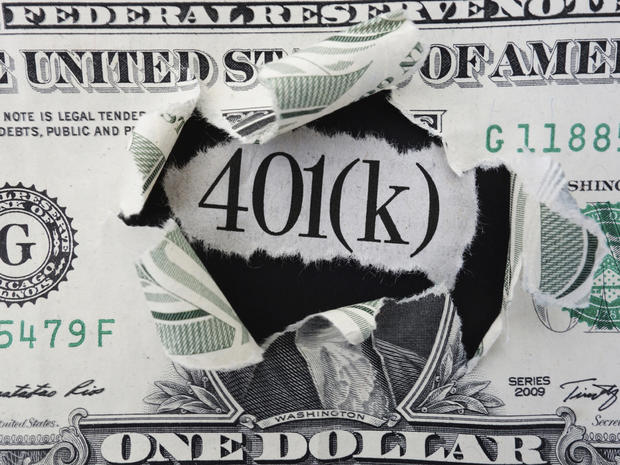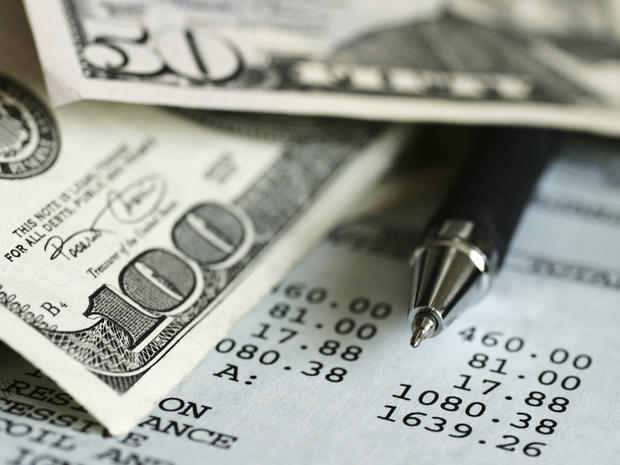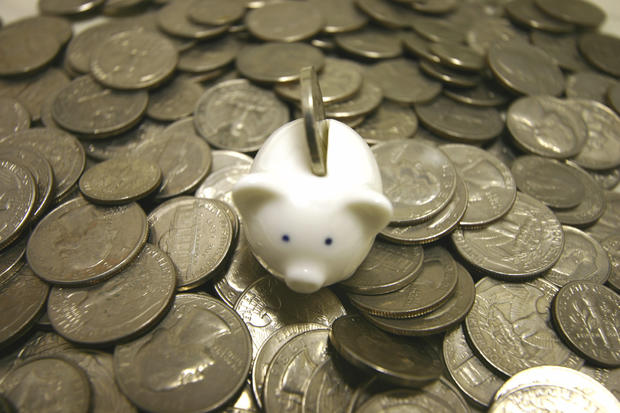17 clever ways to save more for retirement
By Cameron Huddleston/GOBankingRates
Many workers, including those nearing retirement age, say they're not saving enough to retire comfortably. Those concerns were illuminated in the recently released 2015 Retirement Confidence Survey by the Employee Benefit Research Institute and Greenwald & Associates. Of 1,003 workers surveyed, more than half say they have less than $25,000 saved, and nearly 30 percent say they have less than $1,000 in savings.
Some of the workers surveyed say they were unable to save because they're barely making ends meet. Others, however, admitted that they could be doing a better job saving, perhaps with a little more motivation or discipline. If that sounds familiar, keep on reading.
GoBankingRates asked financial planners and retirement experts for their favorite strategies for squeezing more savings out of a paycheck. Perhaps you've heard of some of these clever ways to save --- but they're worth repeating.
Click ahead for some clever ways to boost your retirement savings.
This article, 17 clever ways to save more for retirement, was originally published onGOBankingRates.com.
More from GOBankingRates:
1. Calculate what you need to save
Many people don't know how much they need to put away for their retirement, said Kathleen Hastings, a certified financial planner and portfolio manager with FBB Capital Partners. "Unless you have a good idea of where you want to be when you retire, you're shooting in the dark with blinders on," she said. So calculate how much you should be setting aside for the standard of living you desire.
Start by using a free online calculator, such as Vanguard's Retirement Income Calculator or the Fidelity myPlan Snapshot, to get a general idea of how much you need to save. Once you have an estimate, you might be more motivated to boost your savings.
2. Automate savings
Don't give yourself the option of whether to set aside money each month. Automate your savings so it's not a choice, said David Brooks, Sr., president and CEO of Verus Wealth Management. That means having contributions to a workplace retirement account such as a 401(k) automatically withdrawn from your paycheck or setting up automatic deposits into an individual account such as an IRA from your checking account.
With this approach, the money is deposited into savings before you have a chance to spend it. Plus, it will save you the time and hassle of having to transfer money to a retirement account each month on your own.
3. Get your employer’s 401(k) match
Would you say no to free money? Probably not. But plenty of employees do each year because they don't contribute enough to their 401(k) to get the full matching contribution from their employer. In fact, one in four plan participants miss out on receiving a full match by not saving enough, leaving an estimated $1,336 of free money on the table, according to research by Financial Engines, an investment advisory service.
Check with your human resources department to find out if your employer offers a 401(k) match. What's most common is when employers contribute 50 cents for every $1 contributed by an employee to his or her 401(k) up to 6 percent, according to the 401kHelpCenter.com. For example, if you earn $40,000 a year and contribute just 3 percent of your salary, but your employer offers a 50-cent match up to 6 percent, you're missing out on $600 a year in free money.
4. Set up your own match
If your employer doesn't match your contributions to your workplace retirement plan, then set up your own match, said Zach Gieske, an operations analyst at Stable Value Investment Association, a nonprofit resource on retirement investing. Instead of purchasing a daily cup of coffee or a take-out lunch, he recommended putting that money into savings.
"It really helps get you in a saving frame of mind, and even has a side benefit of making you more aware of how seemingly little purchases can add up in your budget," Gieske said.
5. Boost your contribution by 1% annually
Increasing the amount you stash away in savings by just 1 percent each year will significantly raise your account balance over the long haul, Brooks said. Here's an example from Fidelity Investments: A 25-year-old earning $40,000 a year who contributes just 1 percent more of his salary each year (or $33 more each month) until age 67 would have $3,870 additional yearly income in retirement, assuming a 7 percent rate of return and a 1.5 percent annual pay raise.
6. Stash your pay raise in a retirement account
People don't often increase their retirement contribution when they get a raise, said Robert Johnson, president and CEO of The American College of Financial Services, which provides continuing education for financial professionals. But it's an easy way to grow your savings.
Workers are already used to making ends meet on their old salary. So continue to live on that and put the raise into a retirement account, Johnson said. Do the same with an annual bonus.
"Your retirement nest egg will increase very quickly if you take that simple step," he said.
7. Put your tax refund in a Roth IRA
Tax refunds might seem like you're getting free money, which increases the desire to spend it, but keep in mind that it's your money that the Internal Revenue Service has collected interest-free. Hastings recommended putting that refund to work for you. Deposit it into a Roth IRA.
You can contribute up to $5,500 in a Roth IRA in 2015 and another $1,000 for a maximum contribution of $6,500 if you're 50 or older. You won't get a tax deduction for your contribution, but withdrawals are tax-free in retirement. Your modified adjusted gross income must be less than $116,000 if you're single or less than $183,000 if you're a married couple filing jointly to contribute the maximum amount.
8. Adjust your withholding allowances
Getting a big tax refund from Uncle Sam means that the government held on to money that you could have used to pay bills or invest. So if you usually get a fat refund, consider adjusting your payroll withholding allowances so you can keep more money in your paycheck each month. The higher number of allowances you claim up to a point, the lower the tax refund.
File a new W-4 form with your employer to claim more allowances. Use the IRS.gov withholding calculator to figure out how many allowances to claim. If you received the average refund of about $3,000, you could get an extra $250 each month by adjusting your withholding. Then deposit that money into a retirement account.
9. Make catch-up contributions
You can kick retirement savings into high gear once you turn age 50 because the IRS tax code lets you make catch-up contributions. In 2015, you can add an extra $6,000 to a 401(k), 403(b) or 457 plan for a maximum contribution of $24,000. You can boost traditional and Roth IRA contributions by $1,000, bringing the total amount you can set aside to $6,500.
10. Start a self-employed retirement account
Being self-employed doesn't mean your retirement savings options are limited. Self-employed individuals can contribute 25 percent of their income, up to a maximum of $53,000,to a Simplified Employee Pension IRA (SEP IRA) or to a 401(k) that you set up with an investment firm such as Fidelity or Charles Schwab.
"One of the most overlooked ways to save for retirement is through a SEP IRA," said Tom Balcom, a certified financial planner in Florida and founder of 1650 Wealth Management.
11. Save in an HSA
A Health Savings Account (HSA) is meant to help people with high-deductible health insurance policies set aside money to cover out-of-pocket medical costs. But it also can be part of a retirement savings plan.
"When in retirement, this account can continue to be used to pay for medical expenses, preserving more of the traditional retirement savings and income," said Christian Sees, owner of Integrus Financial, a financial services company.
Contributions to an HSA are tax-deductible or made with pre-tax dollars. The funds grow tax-deferred and withdrawals for qualified medical expenses are tax-free. In 2015, you can contribute up to $3,350 if you have an individual health insurance policy with a deductible of at least $1,300. If you have family coverage with a deductible of at least $2,600, you can contribute up to $6,650.
12. Downsize, then retire
Don't wait until you retire to downsize to a smaller home. The sooner you cut your housing expenses by downsizing, the more money you'll have to set aside for retirement and the more time that money has to grow.
If you downsize from a $250,000 house to a house that costs $150,000, for example, and factor out the costs of selling and moving (10 percent of the selling price), you'll have $75,000 that can be added to savings, according to a report called Using Your House for Income in Retirement by the Center for Retirement Research at Boston College.
Consider this: If you withdraw 4 percent of that $75,000 annually, according to the report's calculations, you can increase your yearly income in retirement by $3,000. If you downsize even earlier, say in your 40s, and invest that $75,000 in a portfolio with a mix of stocks and bonds with a 6.5 percent annual rate of return, it could grow to nearly $250,000 over 20 years.
13. Save spare change
Tossing spare change in a jar might seem like an old-fashioned approach to saving, but you'd be surprised how quickly your nickels, dimes and quarters can add up. "Cash it in twice a year and put it into a savings account that you never touch," said John Graves, author of The 7% Solution: You Can Afford Retirement.
You can take a slightly more sophisticated approach by letting your bank do this for you. For example, Bank of America's Keep the Change Savings Program will round up debit card purchases to the nearest dollar and transfer the difference to a savings account. Graves said his account at Wells Fargo allows him to designate an amount to be automatically transferred from checking to savings every time he makes a purchase. See if your bank offers a similar feature.
14. Use an app or online tool
Mobile apps make it easy to automate your savings if you lack the discipline to do it on your own. For example, the SavedPlus app moves a percentage of the amount you spend on purchases into your savings account. It claims that its users save, on average, $350 a month. Or you can link the Acorns app to your debit or credit card, and it will round up your purchases to the nearest dollar and invest the difference into a diversified portfolio of index funds.
Digit is a free online service that links to your checking account and analyzes your income and spending habits to figure out how much you can set aside in savings. The service then automatically puts that money into savings for you. The Digit savings account does not earn interest, though, so you'll want to move the money into an interest-bearing account.
15. Invest what you save
People often talk about how much they saved on groceries, clothes, gas and more. "But do they really save it?" said John Sweeney, executive vice president of retirement and investing strategies at Fidelity Investments. "If you 'saved' money at the pump or the grocery store, then why not literally save it?"
Keep track of how much you saved by using coupons or buying items on sale and put that money into a savings or retirement account. "You'll see how quickly $10 to $20 here and there can add up," Sweeney said.
16. Claim lost money and invest it
States hold billions of dollars in unclaimed assets, from money in inactive savings accounts to uncashed payroll checks, unclaimed pensions and tax refunds, insurance payments and more. The federal government also holds onto lost money. Some of it may be yours.
Visit MissingMoney.com to search its database of unclaimed property records at participating states. Or you can search state-by-state through the National Association of Unclaimed Property Administrators. You can use the Where's My Refund tool at IRS.gov to see if you're owed a tax refund. And you can search for unclaimed savings bonds at TreasuryHunt.gov. Deposit any money you find into your retirement savings.
17. Save for your spouse
Typically, you must have earned income to contribute to an IRA. However, if you work but your spouse does not, you can make contributions for your partner in a spousal IRA.
You must be married and file a joint tax return and can contribute up to $5,500 a year ($6,500 if you're 50 or older). You can choose either a traditional IRA or a Roth IRA if your income falls below certain levels. This is a solid approach to creating a nest egg for a non-working spouse or stay-at-home parent.

















